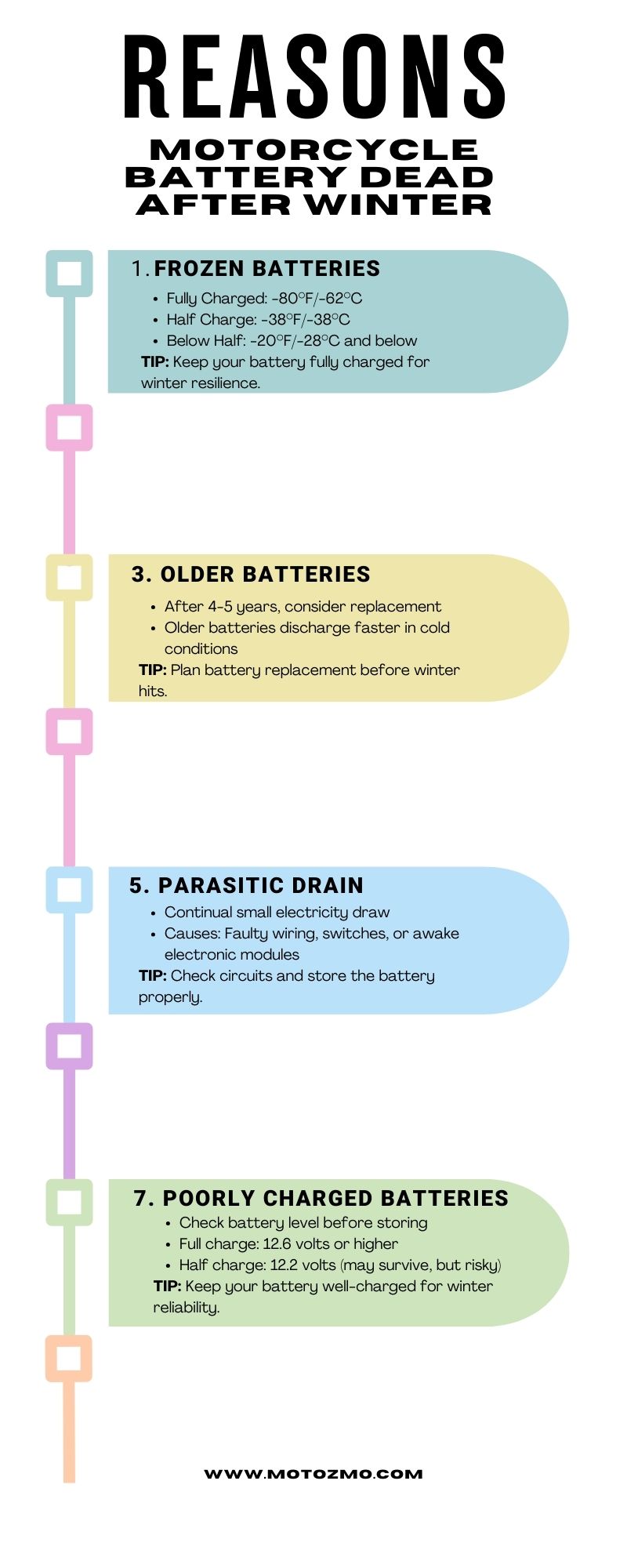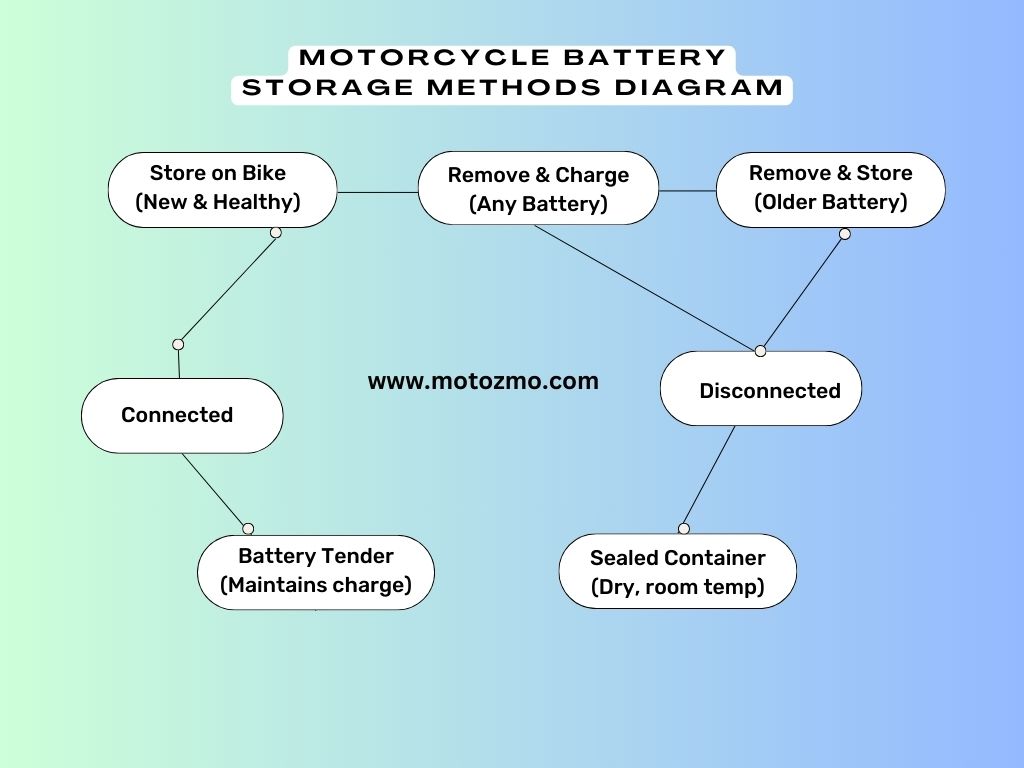Has your old bike left you stranded come springtime again? You’re not alone. Many riders find themselves with disappointing dead batteries after a long winter hibernation.
But do we really understand what goes on under the hood during those frozen months? And are we taking the proper precautions to keep them powered up?
We’ll explore the most common culprits that leave the motorcycle battery dead after winter. Some simple maintenance tasks will keep them juiced all winter long.
Key Takeaways
- Batteries can freeze at different temperatures depending on their charge level.
- Fully charged batteries can withstand much colder temps than those at 50% or less.
- Older batteries 4+ years old have a harder time holding a charge over winter and are more susceptible to drain.
- Parasitic drain from small electrical faults can slowly drain batteries even when disconnected from the bike.
- Lithium batteries perform better than lead-acid in freezing conditions.
Reasons Motorcycle Battery Dead After Winter
Winter weather can wreak havoc on motorcycle batteries, causing them to lose charge due to cold temperatures, reduced activity, and the bike’s electrical systems draining power over time.
Let’s discuss these factors and find out the proactive measures that can be taken.
1. Frozen Batteries
Most people don’t realize that extremely cold temperatures can actually cause motorcycle batteries to freeze right up.
The electrolyte fluid inside starts to ice over below a certain point. And once that happens, the battery is done for, it won’t hold a charge anymore.
The temperature it takes for a battery to freeze depends on how fully charged it is.
A fully charged battery can handle colder temps than one that’s only half full.
Here are the freezing points for different charge levels:
| Charge Level | Estimated Freezing Point (°F) | Estimated Freezing Point (°C) |
|---|---|---|
| 100% Charged | -80 | -62 |
| 50% Charged | -38 | -38 |
| Below 50% Charged | -20 | -28 |
a. Fully Charged
A battery that’s 100% charged won’t freeze until around -80°F/-62°C. That’s really darn cold!
So if you keep your bike’s battery topped up, it should survive most anything old man winter can throw at it.
b. Half Charge
A battery at the halfway mark freezes at around -38°F/-38°C. That’s still pretty cold, but not unheard of for winter nights in many places.
c. Below Half
Anything less than half charge? It could freeze anywhere from -20°F/-28°C and below. Pretty mild temperatures by winter standards.
As you can see, the charge level makes a big difference in freezing resistance. A full battery has nothing to worry about from cold.
But a battery running low on juice is at serious risk even in just slightly frigid temps.
2. Older Batteries
As motorcycle batteries get on in years, they have a harder time holding up to cold weather like they did in their prime.
Older batteries have harder time withholding charge and winter conditions.
The older a battery gets, the less able it is to cling to a charge when it’s been sitting for a while.
Those chemical reactions that produce power are not as powerful as in a new unit. It’ll discharge faster over time, even when not in use.
📌As a general rule, once your battery hits about 4-5 years, it’s ready for retirement.
We’ve seen some old-timers make it longer, but don’t count on it through a harsh winter. Play it safe and plan to replace before things get cold.
The good news? A new battery will feel like it’s barely broken in after a long, cold season. You’ll have many more miles of carefree riding ahead of you both!
3. Parasitic Drain
A parasitic drain happens when small amounts of electricity are continually drawn from your battery, even when you think everything’s shut off and disconnected.
It can be caused by faulty wiring, switches that don’t fully disconnect, or electronic modules that stay partially awake.
On its own, a parasitic drain may only be a few milliamps, but when they feast around the clock for weeks or months over winter, that little sip adds up to an empty battery quick. Before you know it, your battery is as dry as a bone come spring.
The best way to deal with this issue is preventative maintenance. Have any problem circuits checked before storage.
Store the battery on a charger or remove it entirely and store somewhere in a dry and warm place. This will help your battery survive another season.
4. Poorly Charged Batteries
More often than not, a battery this low on charge just can’t cut it through the cold months.
Checking the battery level before storing it.
Full is best, but you’ll want to keep an eye on how charged your battery is as winter bears down. Use a battery charger or multimeter to check the voltage.
📌A good battery should read 12.6 volts or higher. Anything below 12.4 is playing with fire.
Batteries at half charge around 12.2 volts can sometimes make it, but the cold really works against them. The magic freezing temp for a 50% battery is -38°F/-38°C. Much below and you’re asking for trouble.
Once you dip below that half-charge mark, all bets are off.
Batteries in the 12.0-12.2 volt range could ice up in temps most folks would consider barely chilly. They won’t survive in a serious cold weather.

How to Maintain Motorcycle Batteries in Winter
With cold weather on the way, it’s time to make sure your battery is in tip-top shape to handle the long seasonal hibernation.
- The number one thing you can do is give that battery a full charge before storing your ride. Shoot for 100% on the meter. A full battery keeps those cells active all winter long.
- Most batteries only take 6-8 hours for a full charge using a quality charger. Toss it on overnight and you’re good to go come morning.
- Once charged up, it’s time to get your bike winterized and tucked away nice and snug.
- If possible, store your motorcycle indoors away from the elements in a garage or carport. This shields it from freezing rain, snow and bitter winds.
- At minimum, use a breathable motorcycle cover. Not only does this protect the paint from UV rays, it adds an extra layer of insulation from chilly drafts. Just be sure not to completely enclose it, as moisture can build up under there.
Taking these small steps ensures your battery stays active all winter rather than slowly pooping out from the cold. Then come riding season, you’ll be first on the road instead of scrambling for a replacement!
There are some routine maintenance tasks to keep the battery in a first-class condition:
- Nothing’ll drain a battery faster than underlying electrical issues. Let’s deal with those parasites before the problem gets worse.
- Check for any obvious shorts or loose wires that could cause a parasitic drain over winter. Tighten what’s loose and fix what’s broken before storing.
- If you’re not sure where a short may be hiding, it don’t hurt to get a mechanic’s knowledgeable eyes on things. They can usually sniff out tricky problems.
- Take it steady on those starter motors in the frigid temps. Avoid grinding away if it’s too cold – let the bike warm up first so things moving easier.
How Long Can Motorcycle Batteries Sit Before Dying?
We’ve all heard you should charge a battery before long-term storage. But just how long can they last?
With a full tank of juice, a fresh-faced new battery can generally go around 3 months before it starts craving a refill. That’s plenty of time to get through winter.
But don’t expect such longevity from an older battery that’s been through the wringer. If your battery has hit middle age at around the 2-3 year mark, it may only push 1 month when half full before requiring a recharge.
Real antiques over 5 years should be recharged every 2-3 weeks max when in retirement, just to be safe. Their thirst only increases with age.
You must check in regularly, at least monthly, to keep all batteries topped off in storage.

➡️ Explanation:
This diagram shows three main storage methods for motorcycle batteries during winter:
- Storing on the bike (for new and healthy batteries): Connect the battery to a battery tender to maintain its charge throughout storage.
- Removing and storing the battery (for older batteries): Disconnect the battery cables and store it in a sealed container in a dry, room-temperature environment.
- Removing and charging the battery (for any battery): This method is optional but provides the best chance of maintaining a full charge. Disconnect the battery cables, charge it fully using a battery charger, and then store it in a sealed container in a dry, room-temperature environment.
Additional notes:
- Regardless of the storage method, it’s crucial to clean the battery terminals and surrounding area before storage to prevent corrosion.
- Check the battery voltage periodically throughout storage to ensure it stays within acceptable levels.
- Always refer to your motorcycle’s owner’s manual and battery manufacturer’s recommendations for specific storage instructions.
What Is the Best Motorcycle Battery for Cold Weather?
If you’re looking for the heavyweight champs of winter, lithium batteries are your contenders. These newfangled batteries can take the deep freeze and keep on ticking.
Where old-school lead-acid batteries start getting moody below freezing, lithium units actually improve in chilly temps! They can roll with temperatures that would KO the competition.
But there’s always more to the story than headlines. Before installing any new battery, it’s best to check with experts.
A trusted technician can offer insights for your climate and ride. They’ve seen it all and know what lasts long-term in different conditions.
Battery pick depends on how you use your bike. A commuter wants longevity, while a racer needs powerful bursts. Discuss your needs.
New battery tech keeps advancing. Research your options thoroughly before investing. With the right intel, you’ll pick a champion to power through many winters!
The Final Words
Keeping your motorcycle battery happy during winter doesn’t have to be a complex mystery. By following these simple tips, you can ensure a smooth start come springtime. Remember, a full charge is your best friend, and addressing all electrical issues before storage goes a long way. So, take care of your battery to give it a long, healthy life.
Share this article with your fellow riders to spread the knowledge and keep everyone’s batteries healthy.
Leave a comment below if you have any questions or storage tips of your own!
FAQs About Motorcycle Battery Dead After Winter
Can I charge my battery with a trickle charger over the winter?
Yes, using a trickle charger that clips directly to the battery is a great way to keep it fully charged during storage. Set it to a low amperage maintenance charge.
How do I know if my battery needs to be replaced?
Signs it’s time for a new battery include inability to hold a full charge, battery is over 4-5 years old, or if it struggles to turn the starter after sitting. You can also have a mechanic load test it.
What’s the best way to store an old battery over winter?
For older batteries prone to drain, remove it from the bike and store inside, out of freezing areas. Check and recharge it every 2-3 weeks to keep it in stable condition through the cold months.
Can I charge my battery if it’s frozen?
No, never attempt to charge a frozen battery. Thaw it out gradually in a warm area first before recharging once thawed completely with no ice remaining.
How cold is too cold to start my bike?
As a rule of thumb, don’t attempt starting below 10°F without warm-up to protect the battery and moving parts. Above 10°F is usually safe if the engine has time to warm up first.




